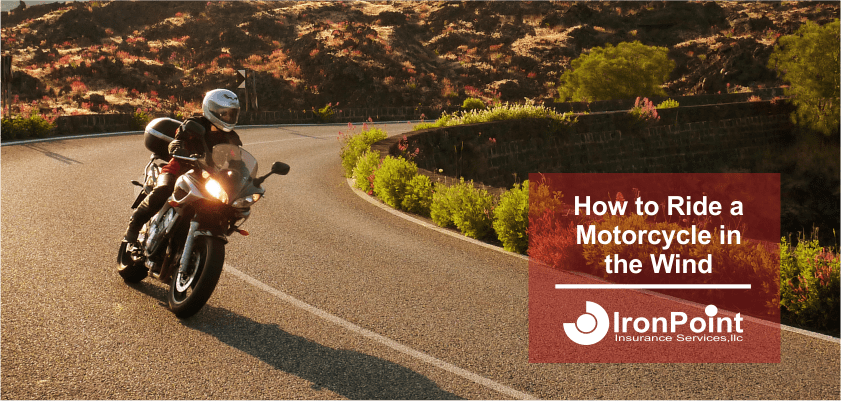How to Safely Ride a Motorcycle in the Wind

Every new rider gets a jolt of adrenaline the first time they ride across a windy bridge, through a gusty canyon, or has a large truck pass in the opposite lane on a small highway. The effect of wind, especially when it’s sudden, can be unnerving. Knowing how to ride a motorcycle in the wind is an essential skill for all riders.
While being light is great for acceleration and carving up canyon roads, it’s a liability in gusty or high winds. Because they are light, motorcycles are more vulnerable to wind gusts. Ask any biker who has battled high winds, they’ll tell you a rider feels pretty small compared to even the most modest of Mother Nature’s powers – the wind.
Tips to ride a motorcycle in the wind
Nature will provide riders with a variety of wind hazards. From head-on winds to strong cross gusts, riders need to know how to ride in windy conditions. Additionally, nature is not the only source of wind, riders will also face wind hazards from other vehicles on the road. Regardless of the source, below are some tips for when you ride a motorcycle in the wind:
Before you ride
- Have a plan: Before you ride it’s always a good idea to check the weather conditions. If the forecast calls for bad weather or has wind advisories, consider changing plans.
- Wear the proper gear: Sure, this is something you hear a lot – wear the proper gear. However, if you have to ride in a strong wind, gear becomes more important. For instance, with good eye protection and a quality, aerodynamic helmet, you’ll not only improve safety but make your ride more comfortable. Wind, of course, can also make conditions feel colder—be sure to wear comfortable layers.
While riding
- Keep your cool: When you ride a motorcycle in the wind, it’s important to remain relaxed. Don’t get tense in your shoulders and keep a normal grip. Keep your mind focused on the road and don’t make sudden reactions, avoid sharp turns, and apply your brakes smoothly.
- Always be looking ahead: Riders should always be hyper-aware of their environment and be scanning and anticipating hazards. In windy conditions, identifying gusts in the trees or flags swaying in the distance can help you anticipate changes in wind patterns. More importantly, looking ahead will help alert you to potential road hazards like debris blowing into the roadway. Be more aware of larger vehicles, as they will only create more wind hazards than normal.
- Tuck down: When the wind is applied against your forward momentum, you can feel pushed back or side-to-side. Like a racer tucking down to become more aerodynamic, tuck your body down close to the tank, with knees hugging the sides of the tank. This will lower your profile and reduce your resistance to the wind.
- Lean into the wind: When you feel wind pressure, just the slightest lean into the gust can help you feel more stable. Keep a normal grip, and lean ever so slightly into the wind. When the wind lets up, be prepared to correct your lane position.
- Stick out a knee: If you’re riding in a crosswind, it may be helpful to point your knee in the direction of the wind. This can produce a “sail” effect that will slightly counteract the effect of the crosswind.
- Apply a steady throttle: Erratic changes in speed can add to your instability in windy conditions. Obviously, riding at a safe speed for your conditions is paramount in bad weather. Find a good, safe speed when riding in the wind. This may mean riding a bit slower. The important thing is to remain steady with your throttle and maintain speed. Additionally, if you’re riding directly into a headwind, you will need to adjust your throttle to adjust to the blowback.
Bonus tips
- Go ahead and stand up: This may sound crazy, and it’s the opposite of the “tuck” tip above, but in some circumstances, this works. Depending on the direction of the wind, standing slightly on the pegs can lower your center of gravity. In this position, it’s possible to create additional stability. The key here is to stand “slightly.” Don’t stand up fully, that won’t work at all.
- Take a break: This may be the best tip of them all. Simply take a break and wait it out. If you can’t find a coffee shop, hangout, or restaurant, park on the side of a building away from the wind for protection and let it pass. Fighting the wind can be exhausting, so this is a great opportunity to drink water, stretch, and get some rest.
The bottom line
It’s important to remember when you’re riding your motorcycle there are always risks. However, as with all things, practicing good safety habits and experience will help you enjoy the road. It’s not recommended that you ride in high, gusty winds, but if it happens use good judgment and employ what you’ve learned and you’ll do fine.
It’s also helpful if you hit the road with the right motorcycle insurance too. If you’d like to review your policy or have any questions about coverage, you can call us at (877) 334-7646 or request a quote online.
Let’s Get Started
Select the way you want to start your quote.







